Allusions in a christmas carol – Embark on a literary journey through A Christmas Carol, where allusions dance amidst the festive cheer, enriching the story’s tapestry with biblical, historical, and cultural references. These allusions breathe life into the characters, enhance the themes, and connect the tale to the Victorian era and beyond.
Prepare to be captivated as we explore the profound impact of allusions in this timeless classic.
Introduction
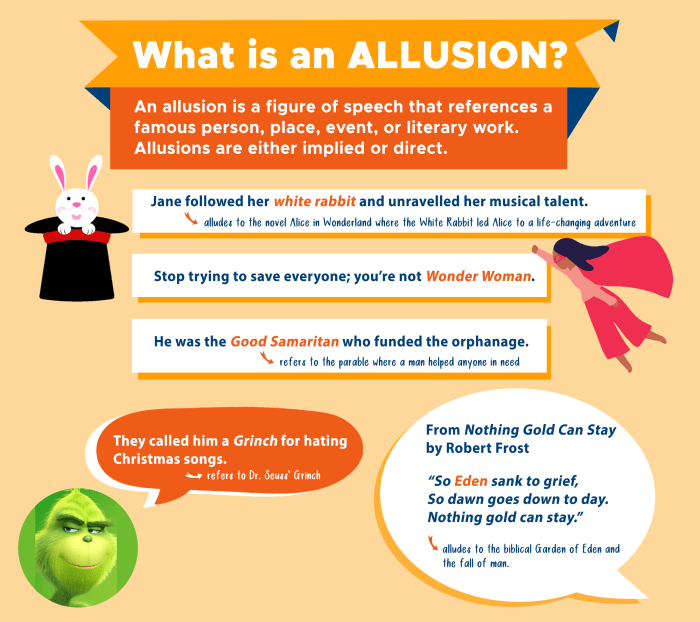
Charles Dickens’ “A Christmas Carol” is a timeless classic that captures the spirit of the holiday season. The novella follows the journey of Ebenezer Scrooge, a miserly old man who is visited by three spirits on Christmas Eve. These spirits take Scrooge on a journey through his past, present, and future, helping him to see the error of his ways and embrace the true meaning of Christmas.
Allusions are a powerful literary device that can enhance storytelling by creating connections between different texts, cultures, or historical events. In “A Christmas Carol,” Dickens uses allusions to create a rich and layered narrative that resonates with readers on multiple levels.
Significance of Allusions
Allusions can serve a variety of purposes in literature, including:
- Establishing a sense of time and place
- Creating a connection between the story and the reader’s own experiences
- Adding depth and complexity to characters and themes
- Providing a sense of humor or irony
Biblical Allusions
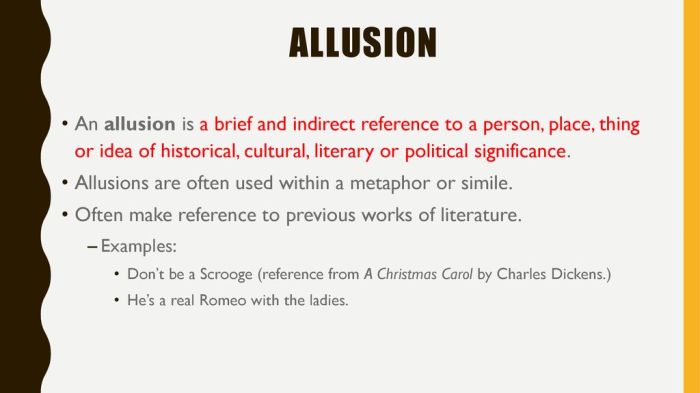
The story of “A Christmas Carol” is steeped in biblical allusions, references to the Bible and its teachings that enhance the story’s themes and character development.
In A Christmas Carol, allusions enrich the narrative by referencing historical events and literary works. Similarly, in The Outsiders, S.E. Hinton’s use of the blue mustang as a symbol evokes the untamed spirit of the Greasers, drawing parallels to the allusions that enhance the depth of A Christmas Carol.
The Ghost of Jacob Marley
Jacob Marley, Scrooge’s former business partner, appears as a ghost bound by heavy chains. These chains symbolize the weight of his sins and the consequences of his greed and selfishness. The allusion to the biblical concept of judgment and punishment for wrongdoing adds depth to Marley’s character and serves as a warning to Scrooge.
The Ghost of Christmas Past
The Ghost of Christmas Past takes Scrooge on a journey through his past, showing him scenes from his childhood and young adulthood. This allusion to the biblical concept of repentance and redemption highlights Scrooge’s opportunity to change his ways and make amends for his past mistakes.
The Ghost of Christmas Present
The Ghost of Christmas Present shows Scrooge the joy and generosity of Christmas, particularly among the poor and underprivileged. This allusion to the biblical teachings of compassion and charity emphasizes the importance of helping others and spreading goodwill during the holiday season.
The Ghost of Christmas Yet to Come
The Ghost of Christmas Yet to Come reveals Scrooge’s possible future if he continues on his current path. This allusion to the biblical concept of prophecy and consequences serves as a wake-up call for Scrooge, prompting him to change his ways before it’s too late.
Historical Allusions
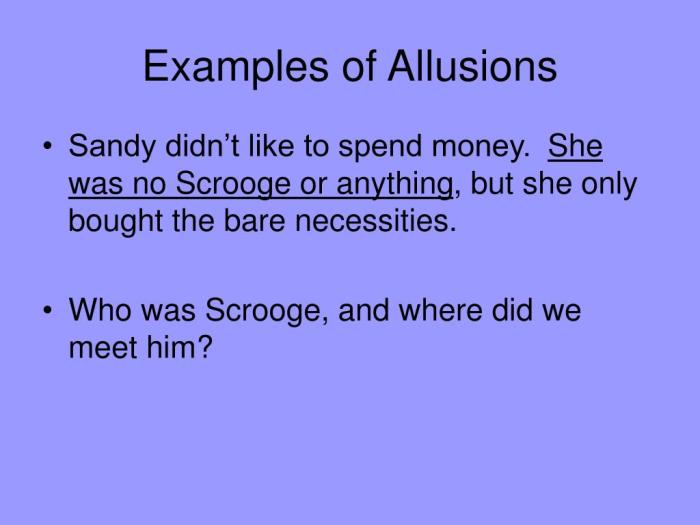
The story of A Christmas Carol contains several historical allusions that connect it to real-world events and enhance its realism.
One such allusion is to the Industrial Revolution. Scrooge’s counting-house is described as being filled with “fog and cold,” and his employees are depicted as working long hours in harsh conditions. This reflects the working conditions of many people during the Industrial Revolution, who were often forced to work in dangerous and unsanitary factories.
The Poor Law
Another historical allusion in the story is to the Poor Law. The Poor Law was a system of laws that provided relief to the poor. However, the Poor Law was often criticized for being harsh and unsympathetic to the poor.
In A Christmas Carol, Scrooge’s nephew, Fred, criticizes the Poor Law, saying that it is “a cruel and heartless law.” This criticism reflects the growing dissatisfaction with the Poor Law that was felt by many people during the Victorian era.
Literary Allusions: Allusions In A Christmas Carol
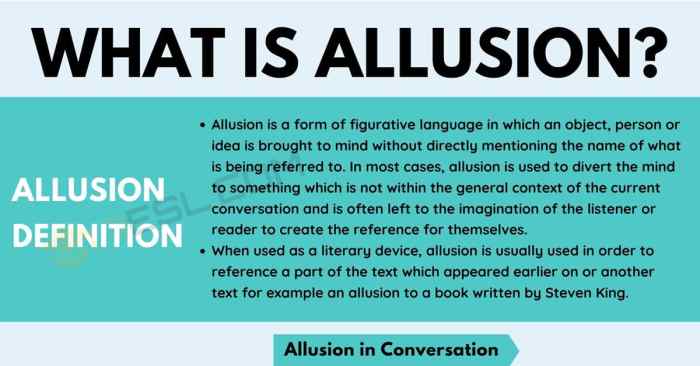
Dickens incorporates numerous literary allusions in “A Christmas Carol” to enhance its literary value and create intertextual connections with other literary works.
These allusions establish a broader literary context and enrich the story’s themes and characters.
Allusion to Shakespeare’s “Hamlet”
Dickens alludes to Shakespeare’s “Hamlet” when Scrooge encounters the Ghost of Jacob Marley, who is described as “a ponderous chain of office, bound with many rings” (Stave 1). This imagery mirrors the description of the ghost of Hamlet’s father, who appears as “an armed head” and wears “a crown of thorns” (Act I, Scene iv).
This allusion suggests a connection between Scrooge’s miserliness and Hamlet’s guilt and indecision, highlighting the consequences of neglecting one’s responsibilities and relationships.
Allusion to Dante’s “Inferno”
The Ghost of Christmas Present takes Scrooge on a journey through a desolate landscape filled with suffering and despair, reminiscent of Dante’s “Inferno.” Scrooge witnesses the impoverished Cratchit family, who endure hardships despite their virtuous nature.
This allusion draws parallels between the Cratchits’ plight and the suffering endured by those in Dante’s hell, emphasizing the consequences of social inequality and the importance of compassion.
Cultural Allusions
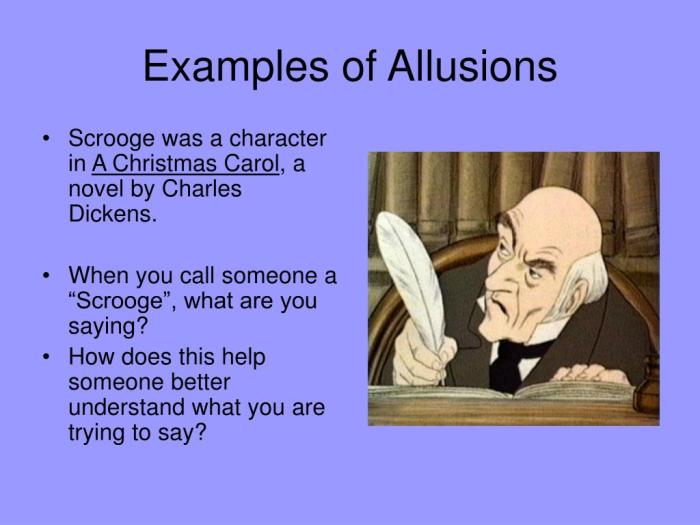
Dickens’s A Christmas Carolis replete with cultural allusions that reflect the Victorian era’s social norms and values. These allusions provide a glimpse into the beliefs, customs, and practices of the time, enriching the story’s social commentary and relevance.
Christmas Traditions
- The story emphasizes the importance of Christmas as a time for family, feasting, and charity, reflecting the Victorian tradition of celebrating Christmas as a family-oriented festival.
- The reference to the “Christmas goose” alludes to the custom of having a special meal on Christmas Day, a practice that continues to be popular today.
Social Classes, Allusions in a christmas carol
- The portrayal of Scrooge as a wealthy but miserly businessman reflects the Victorian era’s preoccupation with class distinctions and the belief in the moral superiority of the upper classes.
- The Ghost of Christmas Present’s visit to the Cratchit family, who live in poverty, highlights the vast social inequality that existed during this period.
Industrialization
- The mention of factories and industrial machinery in the story alludes to the rapid industrialization of the Victorian era, which brought both economic prosperity and social problems.
- The Ghost of Christmas Future’s vision of a “dreary moor” where the poor are left to die suggests the social consequences of industrialization, including poverty, homelessness, and disease.
Symbolism and Allegory
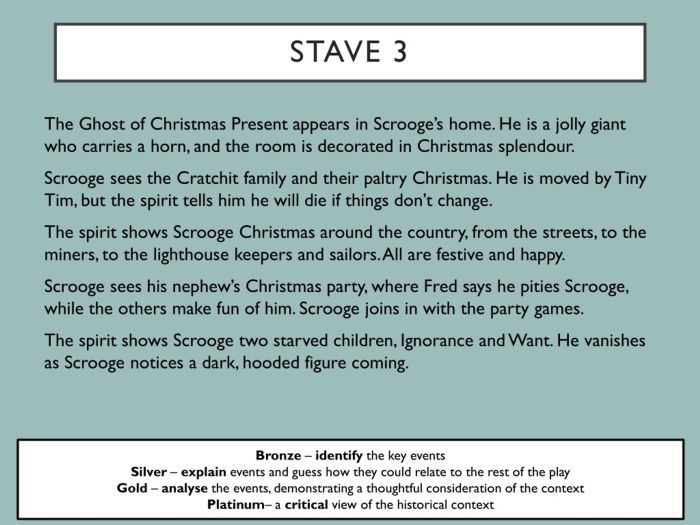
In “A Christmas Carol,” Dickens employs a rich tapestry of symbols and allegories to convey profound moral lessons and enhance the story’s emotional resonance. These elements provide deeper insights into the characters, themes, and the transformative power of redemption.
The Ghost of Christmas Past
This spirit represents Scrooge’s forgotten memories and missed opportunities. His appearance as a childlike figure symbolizes the innocence and wonder of the past, while the candle he carries illuminates both the joys and regrets of Scrooge’s life.
The Ghost of Christmas Present
This spirit embodies the spirit of generosity and compassion. His jovial demeanor and the abundance of food and merriments he brings represent the transformative power of kindness and the importance of sharing with others.
The Ghost of Christmas Yet to Come
This somber figure symbolizes the consequences of Scrooge’s selfish actions. His appearance as a shrouded, silent figure evokes a sense of foreboding and the inevitability of death. He serves as a stark reminder of the importance of living a life filled with purpose and compassion.
Scrooge’s Transformation
Scrooge’s journey from miser to philanthropist is a powerful allegory for the transformative power of redemption. His initial resistance to the spirits’ visits represents his stubborn adherence to his old ways. However, as he witnesses the consequences of his actions and the joy that kindness can bring, he undergoes a profound transformation, symbolizing the potential for change and the importance of embracing a life of compassion and generosity.
FAQ Compilation
What is the significance of biblical allusions in A Christmas Carol?
Biblical allusions provide a moral and spiritual framework for the story, emphasizing themes of redemption, charity, and the transformative power of love.
How do historical allusions contribute to the realism of the story?
Historical allusions ground the story in the social and economic realities of Victorian England, making the characters and events more relatable.
What is the purpose of literary allusions in A Christmas Carol?
Literary allusions create intertextual connections, enriching the story’s literary value and inviting readers to explore the broader literary landscape.
